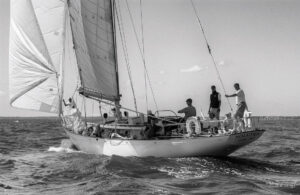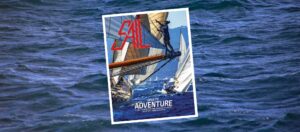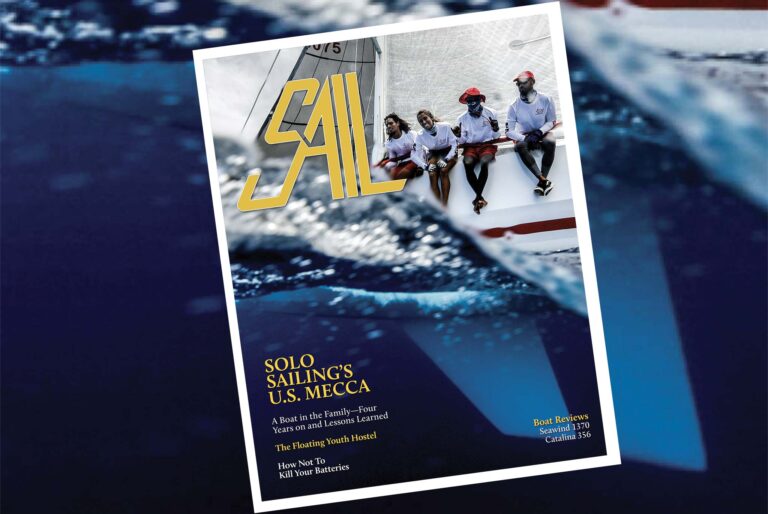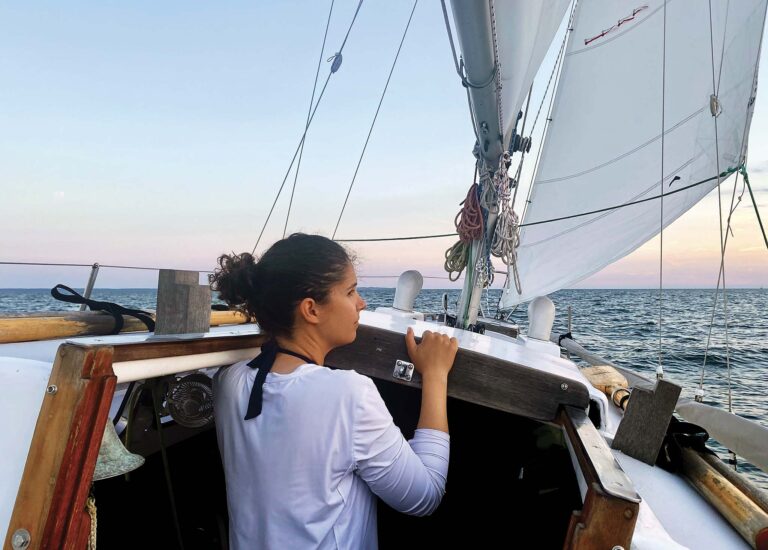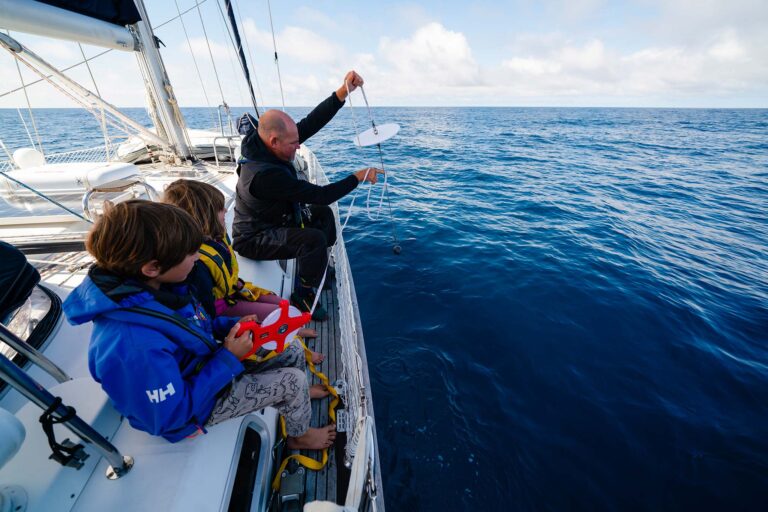
Learning to sail is an organic process. Often we’re introduced to the sport by a family member or good friend who loves sailing and wants to share their passion. As such, one learns in bits and pieces. The problem is you can end up with lots of missing bits, and thus many sailors with decades of experience have huge gaps in their training. As it turned out, I was one of those sailors.
It was my grandfather who first taught me how to sail. Later, as an adult, I purchased a C&C 30 and cruised and raced for 10 years on Chesapeake Bay. I’ve also skippered long ocean passages, crewed in numerous races and chartered across the globe. However, it wasn’t until I applied for my United States Coast Guard (USCG) Master’s Credential that I realized I still had a lot to learn.
Simply said, the test is massive, covering a wide range of material, much of which was foreign to me. It was clear I’d need some help getting prepared. So I did some research and found a highly recommended online maritime school called the Training Resources Maritime Institute that offered a series of online preparation courses.

It took me six full months to study the material for the theoretical exam, and I was still sweating bullets during the eight-hour test. It didn’t help that I was the only one taking the test that day and that the proctor was a retired U.S. Navy Admiral with a limited sense of humor.
Clearly there was some material on the exam I don’t think I’ll ever need (such as what lights need to be shown at night on a power-driven vessel pushing ahead or towing alongside on the Western Rivers above the Huey P. Long Bridge on the Mississippi River). However, the majority of the information speaks to skills and knowledge that anyone in command of a vessel should possess and I’m glad of the studying I did.
As my father likes to say, “Sailing is 95 percent pure joy and 5 percent terror.” And in many ways he’s right. Being a good sailor is not just about being able to handle a boat on a clear day with 12 knots of wind on the beam. It’s knowing what to do when things go wrong.
This is not, however, where my story ends. Fresh on the heels of passing the USCG exam, I started looking into chartering a boat in Croatia. However, much to my chagrin, I discovered Croatia did not honor or even recognize my hard-earned USCG credentials. What was recognized, I learned, was the Royal Yachting Association (RYA) Yachtmaster certificates that are more or less the gold standard for leisure and commercial boating in Europe.
Thus began the process of finding out how I could qualify for the Yachtmaster Offshore certification. Luckily, the RYA recognized my sea time, and my USCG qualification was accepted in lieu of the RYA’s theoretical requirements. However, I still had to do a practical test and get my VHF radio license.
I now live in Munich, Germany, so I started searching for a convenient testing center near home and soon learned that charter company Sunsail offers the Yachtmaster practical training and testing at its Portsmouth, UK, sailing school in the legendary Solent.
Flights to England are relatively cheap and easy from Munich. However, the Solent, with its tides, rough weather and high level of commercial shipping traffic, is also one of the more challenging environments in which to take the test. In addition, Sunsail only offers the course in winter, because of the high demand for its fleet during summer months. (Although, there is any number of other RYA-accredited sailing schools in the UK that offer the course and test as well.) To add a final layer of complexity, of course, the British use the IALA Region A buoyage system, which means in English waters green buoys are left to starboard when one is heading into port.

Still, in the spirit of becoming a better sailor, I figured the more difficult the challenge, the more I’d learn. So, I went ahead and signed up for the next available slot that November.
Like other British sailing schools, Sunsail’s prep course (a highly recommended prerequisite to the RYA Yachtmaster exam) is a five-day on-the-boat affair. After that, the RYA examiner comes on board and tests two people at a time in succession. Since there were four of us, the exam would take two full days and nights. All four of us needed to be on board the entire time to serve as crew.
Much like the USCG test, there is a good bit of material and data we needed to know to pass the RYA practical exam. However, the main focus of this test was gauging how well we put this knowledge into action.
For example, I not only had to calculate when the next high tide was in Wooton Creek on the Isle of Wight, I also had to write up a passage plan and follow it (to the letter) all the way up to Wooton Bridge and back before the creek ran more or less dry, as it does twice a day at low tide. (As a side note: Wooton Creek has very few lateral marks or other navigational aids, and running aground is an automatic fail.)
Another one of the “fun” maneuvers was bringing our boat to within 150ft of a designated buoy in the middle of the raging Solent in very poor visibility, using only the depth sounder and a paper chart. We simulated very poor visibility by keeping the skipper belowdecks.
Of course, there were also your typical man-overboard drills and other seamanship exercises, all made that much more complex by the fact that we often had to do them in heavy seas, strong current, high winds and crowded anchorages.
Granted, I fully expected the weather in November on the Solent to be cold and wet. (I mean, this is England we’re talking about, after all.) But what I didn’t expect was to have a severe low-pressure system blanketing the region and staying around the entire week. Luckily, I had brought along some good foulweather gear and nice big pair of rubber “wellies,” without which I would not have survived. In spite of the chill rain and high winds, I remained bone dry throughout.
Another useful item I brought along was a tablet loaded with the latest Navionics chartplotter app and maps. The boat we trained and tested on had a built-in chartplotter, but it was annoyingly located at the nav station belowdecks, so you couldn’t use it while at the helm. For the record, RYA examiners don’t want you depending too heavily on electronic navigational aids during the course. (For example, you have to show proficiency at using paper charts and physically write down a passage plan). However, they will let you use electronic chart plotters as a backup, and actually encourage this.
When I first signed up for this course, I thought it would be part vacation, part class. However, the harsh weather provided plenty of challenging moments. In addition, there was a considerable amount of stress and anxiety attached to everyone’s desire to pass the exam. Interestingly, while you might think we would have saved all that stress for when the RYA instructor was actually on board, each of us believed that how we performed during the Sunsail practice sessions was a clear indication of our chances of passing the final test. We, therefore, took our practice maneuvers very seriously.
Our instructor also took them seriously. When we screwed up, his favorite expression was, “That would not qualify you as a Yachtmaster,” which he delivered in a very British fashion with his head slightly turned away and his nose turned up as if to avoid the stink of our horrendous error.
Given that the weather was poor throughout our entire practice session, we were all hoping for some nice conditions for the exam. Nothing doing! The low only intensified, as if in tune with our collective anxiety.

Our general stress peaked on the first day of exams, when one of the candidates failed to successfully spin the boat in a crowded marina while fighting the strong wind and current, ultimately pinning us sideways between two very expensive yachts. It was a miracle we were able to rescue the boat without doing some serious gelcoat damage.
Later that afternoon, while we were tied up at Haslar Marina, the barometer dove even deeper and winds hit gale force. I went to the office to get the latest weather, and they told me it would only get worse. Sure enough, next morning the swells in Portsmouth Harbor looked more suited to surfing than sailing. I could only imagine what it looked like on the unprotected Solent.
As we all sat down to a cold and rather damp breakfast, our instructor told us what we all more or less suspected: the weather was too harsh for us to successfully complete the exam, and we’d have to reschedule. This was especially difficult for me, as I was the only participant who was not from the UK and thus would have to once again arrange flights, trains and accommodations for a second go at the exam. Still, there was really no other option. So, we all packed it in and headed home.
Of course, this news might have included a silver lining if I could have returned in the summer when the Solent was brimming with warm-weather fun. But as I said, Sunsail only offers the class during the winter, and the only slot that worked for me was in early March. Heavens!
On my return, I decided to take the entire course again. I mean, what the heck, I’d had to rebook all my flights and other travel, so I might as well take full advantage of the trip. Sadly, the weather was not that much better than it had been that November, though the Beaufort scale did manage to stay within reason, and we were able to complete the exam.
On this second time around, I had a totally different group and a different instructor, and she was just as good and just as tough as the first one. In fact, taking the course again with a different teacher turned out to be a huge plus, because I got all the information and instruction delivered in a slightly different fashion, which really helped it sink in.

It’s important to note that in spite of the rough weather and the stress of the exam, both training sessions were also a lot of fun. Sure, there were moments when each of us asked ourselves, “Did we really sign up for this?” However, the four of us also experienced some great camaraderie while taking the exam, comparing notes, providing support whenever anyone was struggling and sharing in the joy and excitement whenever anyone pulled off a particularly difficult maneuver. It was especially fun at the end of the day when we all headed off to one of the Solent’s many maritime pubs for some grub, ale and a good laugh over what had gone right and what had gone wrong that day.
Ultimately, I’m happy to report that I did manage to pass my exam the second time around. As to the question of whether I would do it again, absolutely! Would I recommend it to others? Yes, though it also depends on what you’re looking for. If your goal is a commercial license, for example, I would highly recommend either the USCG or RYA certificates. Which you choose depends on where you want to work.
If, on the other hand, you aren’t yet ready for something quite so rigorous, there are any number of other paths you can also take. Organizations like the American Sailing Association (ASA) and US Sailing, for example, offer a wide range of on-water courses for those who want to improve their sailing and have fun while doing it. Whatever course you decide on, I guarantee you’ll be glad you did it.
April 2020

